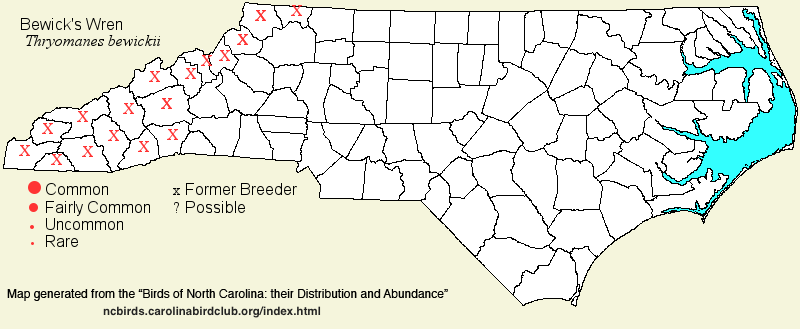 |  |
|
Bewick's Wren - Thryomanes bewickii TROGLODYTIDAE Members: | Search Common: Search Scientific: |
|
|
||||||
| General Comments | The Bewick's Wren is one of the saddest stories in the Eastern United States. As late as the 1920's, the species bred eastward through much of the Appalachians, including many areas of our mountains, and sparingly farther east. They all disappeared from the North Carolina mountains by the 1970's, and in mountains in adjacent states within the next decade. No one has fully explained this extirpation; it certainly is not habitat related. Speculation centers on expansion of House Wrens in the mountains, as the latter is known to kill Bewick's Wrens at nest boxes; House Wrens, though smaller in size, are more aggressive birds than Bewick's Wrens. Other possible competing species include Song Sparrows and House Sparrows. The species nested in the early part of the 20th Century in low elevation farmlands and small towns, even in yards, especially those with outbuildings and fences. In later decades, the wrens disappeared from the valleys, and moved higher, such that after 1950, the few pairs remaining were nesting in higher elevation farmland and pastures, often well over 4,000 feet. Thus, whatever the cause(s), it involved "forcing" the birds into less favorable habitat at higher elevations. Away from the mountains, there were scattered records in migration and winter, but the last believable record for the state was probably in 1995. There is still a report here and there, but they do not pass "muster". | |||||
| Breeding Status | Former Breeder | |||||
| NC BRC List | Definitive | |||||
| State Status | E | |||||
| U.S. Status | ||||||
| State Rank | SXB | |||||
| Global Rank | G5 | |||||
| Coastal Plain | Former transient. At best, formerly casual to very rare, in both spring and fall; no records since 1972. There are about a dozen reports -- Apr and May, and late Aug to early Nov. The last confirmed Bewick's Wren in the state was banded in Clarkton (Bladen) on 14 May 1995 [Chat 60:76 link]. | |||||
| Piedmont | Former transient and winter visitor, and accidental breeder. Casual to very rare at best; there are about seven spring reports (Mar to early May), six fall reports (late Aug to mid-Oct), and four winter reports (Dec - Jan). There are also two old reports of breeding: Guilford, nest-building on 28 Apr 1939 [Chat 18:36 link]; and Forsyth, 3-8 Apr 1950 [Chat 14:67 link], T.G. Pearson et al. Birds of North Carolina p. 270 (rev. ed. 1959). The most recent report is from Iredell on 27 Sep 1984 [Chat 49:53 link]. | |||||
| Mountains | Former summer resident. Once a common breeder in the mountains, but the last confirmed bird on territory was at Mt. Pisgah on the Blue Ridge Parkway (Buncombe), 28-31 May 1971 [Chat 63:112 link]. There are two more recent unconfirmed reports of possible breeding or breeding activity: one at Boone (Watauga) in Jul 1981 [Chat 46:106 link], and one at Asheville (Buncombe) in April 1983 [Chat 47:110 link]. There are also three relatively recent one-day breeding season reports: one at Long Hope Creek (Ashe) on 26 Jul 1973 [Chat 37:4 link]; one at Cable Cove campground (Graham) on 20 Jun 1984 [Chat 49:25 link]; and one at Joyce Kilmer/Slickrock Wilderness Area (Graham) on 16 May 1994 [Chat 59:79 link]. Formerly, probably late Mar to Oct. | |||||
| Finding Tips |
Extirpated as a breeder, and even migrants are extremely rare (and details are always scrutinized by other birders). 1/2* | |||||
| Attribution | LeGrand[2023-03-27], LeGrand[2014-11-15], LeGrand[2012-09-16] | |||||
| NC Map Map depicts all counties with a report (transient or resident) for the species. | Click on county for list of all known species. |
| NC Breeding Season Map Map depicts assumed breeding season abundance for the species. |  |